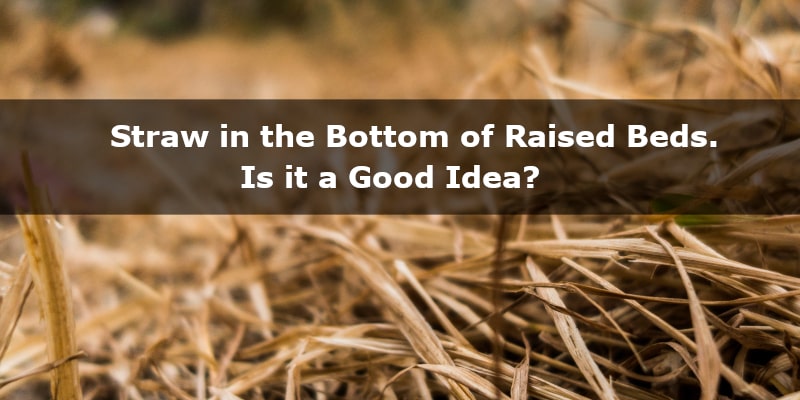Is straw in the bottom of raised beds a good idea?
In this post, we will talk about it!
Is Straw in the Bottom of Raised Beds a Good Idea?
Straw in the bottom of raised beds is a good idea, because it keeps moisture, adds organic matter, and smother weeds. You should be careful to use weed-free straw to prevent weed growth in the future.
There are many benefits of using straw in the bottom of raised beds. Gardeners use it mainly to keep moisture for longer, and smother weeds.
When choosing a straw type, it’s best to use rice, or wheat straw, but the type isn’t as important as the quality. Make sure the straw is the finest quality to prevent problems in the future.
If you want to know more about this topic, keep on reading the article.
What are the Benefits of Using Straw in the Bottom of Raised Beds?
There are 4 main benefits of using straws in the bottom of raised beds.
Keeps Moisture
Raised garden beds tend to dry out quicker than the surrounding soil. Putting a thick blanket of straw keeps the moisture in the soil for much longer, as straw is slowing evaporation. As a result, you won’t have to water your plants every 2-3 days, but once a week.
Adds Organic Matter
As the material at the bottom of your raised bed decomposes, it will add valuable nutrients to your soil. Straw contains phosphorus and moderate amounts of nitrogen and potassium. As a result, your plants will grow all the better.
Smothers Weeds
The main reason to put the straw in the bottom of your raised bed is to prevent weeds and grass from growing up from underneath, as the straw blocks out the sun, preventing most weeds from germinating and growing. This is particularly important if you are buying sterilized soil because you don’t want to spend all that money on weed-free soil just to have it invaded by more weeds and grass.
Reduces Pests and Diseases
Straw also saves crops from developing diseases such as blossom-end rot, cat-facing, or shriveling. Thanks to straw mulch, soil moisture stays even and calcium can be transferred from the soil to plants easily, preventing diseases.
What Type of Straw is the Best for Raised Bed?
The key to using straw as mulch is in finding the right types of straw garden mulch. Some straw mulches may be mixed with hay, which can weed seeds that can sprout in your garden rows. Look for a supplier that sells guaranteed weed-free straw.
You should be particularly fond of straw that has been steamed to kill weed seeds and chopped into finer particle sizes. The finer sizes that it’s been chopped and split to create make the application incredibly easy, and it’s virtually dust-free.
Also, try and source organic straw, as this will be free from the harmful fertilizers and pesticides that are used on conventional fields.
Usually, these are the most reliable types of straws:
- Rice straw
- Wheat straw
- Pine straw
- Barley straw
You can usually find large bags of straw at nearby hardware and tractor supply stores for around $5-10 a bag. You may also find straw in bales at variable costs.
How to Apply Straw in Bottom of Raised Bed?
Bales of straw are so compressed that you might be surprised at how much of your garden one bale will cover. Always start with one and buy more if it’s needed.
While straw will smother weeds on its own, it is better when applied on top of cardboard or newspaper.
Straw adds carbon-rich matter to your raised bed, and the humus that forms as the straw decomposes under the soil will do wonders in the long run.
For best results, add 4-6 inches (10-15 cm) of straw on the bottom of your raised bed.
Be aware that the straw will shrink as it decomposes, so you might have to add a bit more soil to the top of your bed next year.
What Other Things Can You Put in the Bottom of a Raised Bed?
Except for straw, there are other things you can but in the bottom of raised beds to suppress weeds, keep moisture, and prevent diseases.
Cardboard: They choke out weeds, encourage earthworms, keep moisture in the soil, and add organic matter as it decomposes. Carboard will take about 8 to 10 months to decompose, at which time most of the weeds underneath will be dead.
Newspaper: Lay down at least 10 sheets with the edge overlapping to smother weeds, hold moisture, and make a nice compost.
Woody Material: Wood, woodchips or other woody material create a more solid weed barrier that will still decompose over time and feed the soil.
Leaves: Add 2-4 inches (5-10 cm) of leaves to the bottom of your bed to create lots of beneficial humus at the bottom of your raised bed and smother weeds that might try to sneak through.
Rocks: They can improve drainage but they can also cause the ground to become saturated. The water can settle in the rocks until it filters through the clay, keeping the soil in the bed from becoming waterlogged.
Carpet: Natural carpets made from organic materials can be an excellent bottom layer. These carpets will successfully choke weeds and still be permeable for water and deep roots to pass through.
Sources
gardeningchores.com, almanac.com, gardeningknowhow.com, epicgardening.com


